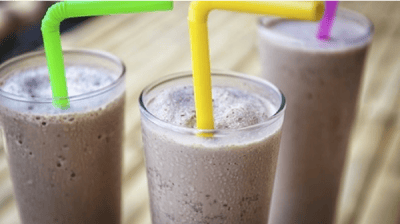 From health gurus to fitness magazines, you’ve probably seen a vast and varied array of opinions surrounding the humble smoothie. Some nutritionists recommend them as an easy way to get more fruits and vegetables into your diet. Other experts condemn the fruit-filled drinks as a source of excess calories and sugar. Here’s a look at the pros and cons of smoothies — as well as some tips for helping you build a better beverage:
From health gurus to fitness magazines, you’ve probably seen a vast and varied array of opinions surrounding the humble smoothie. Some nutritionists recommend them as an easy way to get more fruits and vegetables into your diet. Other experts condemn the fruit-filled drinks as a source of excess calories and sugar. Here’s a look at the pros and cons of smoothies — as well as some tips for helping you build a better beverage:
How smoothies can make healthy eating easier
If you struggle to fit all of your recommended daily servings of fruits and vegetables into your diet, smoothies can make healthy eating easier. Instead of trying to find ways to incorporate every fruit and vegetable into your meal plan, you can transform these nutritious foods into a delicious drink that’s easy to consume when you’re on the go. If there are certain healthy foods you or your kids don’t like to eat, such as leafy greens, smoothies can disguise their flavor and texture. And unlike juicing, which separates the juice from the fiber-rich pulp, smoothies allow you to enjoy all the nutrients that come with eating the whole food.
Making a healthier smoothie
When it comes to making your own smoothies, the possibilities are seemingly endless. Protein can help your smoothie keep you satiated. Health and nutrition journalist Kiersten Hickman suggests giving your beverage a little extra protein with a tablespoon of your favorite nut butter. Another way to make your smoothie more filling is to transform it into a breakfast bowl, explains Hickman. You can do this by pouring your drink into a bowl instead of a glass and adding high-fiber foods like nuts, fruits, seeds, or a healthy cereal. And if you’re looking to give your smoothie additional nutrients you wouldn’t normally eat, Hickman notes smoothies are a great way to make healthy ingredients like collagen powder, flax seeds, and chia seeds a part of your diet.
In addition to adding healthy items to your smoothie, there are a few items you may want to consider leaving out or substituting, depending on your dietary goals. If you’re cutting back on carbs, consider swapping out bananas for non-fat Greek yogurt. You’ll still get a creamy drink, but without the added starch. If you want to cut back on sugar, consider omitting honey, maple syrup, and agave syrup. While these natural sweeteners may have their own benefits, it’s also important to be mindful of the fact that just one tablespoon of honey can add 17 grams of sugar to your drink. Other sugary mix-ins to avoid include canned fruit, ice cream, sorbet, fruit juice, and flavored yogurt.
The potential drawbacks of smoothies
Nutritionists warn of several hidden problems that could accompany your daily smoothie. First, just as smoothies can sneak healthy ingredients into your diet, they can also hide unwanted calories and sugar. These hidden sugars are particularly pervasive in premade smoothies, but homemade drinks can have them, too. According to the British Heart Foundation, even if you don’t add sugar to your drink, the action of blending up fruits and vegetables will destroy their cell walls and make their sugars more available to your body. On top of that, since smoothies are so easy to drink — but calorically dense — they can feel less like a meal and more like a beverage, leaving you with the temptation to graze on snacks.
Want more ideas on how smoothies can fit into your daily diet? Browse online for more resources or speak with a dietitian for tailor-made recommendations.